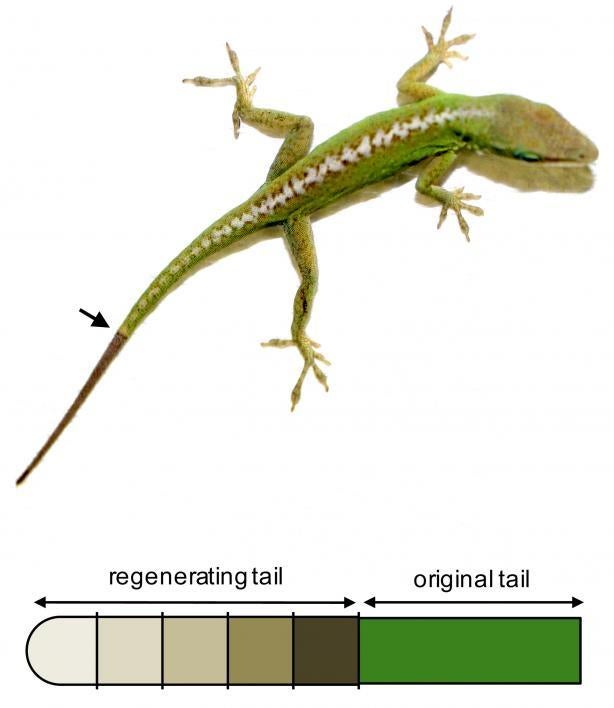Any kid who pulls on a lizard tail knows it can drop off to avoid capture, but how they regrow a new tail remains a mystery. Now, researchers at Arizona State University and the Translational Genomics Research Institute (TGen) have identified tiny RNA switches, known as microRNAs, which may hold the keys to regenerating muscles, cartilage and spinal columns.
In a study published today in the scientific journal BMC Genomics, ASU and TGen scientists for the first time identified three microRNAs — which turn genes on and off — that are associated with the regeneration of tails in the green anole lizard, Anolis carolinensis.
Using next-generation genomic and computer analysis, this interdisciplinary team of scientists hope their findings, following nearly six years of research, will help lead to discoveries of new therapeutic approaches to switch on regeneration genes in humans.
"Since microRNAs are able to control a large number of genes at the same time, like an orchestra conductor leading the musicians, we hypothesized that they had to play a role in regeneration," said senior author Kenro Kusumi, professor in ASU's School of Life Sciences and associate dean in the College of Liberal Arts and Sciences. "Our earlier work found that hundreds of genes are involved in regeneration, and we are very excited to study these three new microRNAs.”
Elizabeth Hutchins, a post-doctoral fellow in TGen’s Neurogenomics Division and co-lead author of the study, said she hopes this investigation eventually enables such things as regenerating cartilage in knees, repairing spinal cords in accident victims, and reproducing the muscles of injured war veterans.
“It is the translational nature of this work — how it could eventually be applied to people — that led to my interest in this study,” said Hutchins, who graduated from ASU's Molecular and Cellular Biology Program. “For example, we currently don’t have the ability to regrow knee cartilage, which would really help someone like my grandmother.”
“This work highlights the importance of tiny RNA molecules in the tissue regeneration process, and showed for the first time an asymmetric microRNA distribution in different portions of the regenerating lizard tails,” said Marco Mangone, a co-author and assistant professor with ASU’s School of Life Sciences and Biodesign Institute. “It seems like microRNAs may play an active role in this process and are potentially able to shape the regenerating lizard tail like playdough.”
The research team also included: Justin Wolter of ASU’s Biodesign Institute and School of Life Sciences; and Walter Eckalbar at the University of California, San Francisco.
This research was funded by grants from the National Institutes of Health and the Arizona Biomedical Research Commission.
Top photo by Kenro Kusumi
More Science and technology

4 ASU researchers named senior members of the National Academy of Inventors
The National Academy of Inventors recently named four Arizona State University researchers as senior members to the prestigious organization.Professor Qiang Chen and associate professors Matthew…

Transforming Arizona’s highways for a smoother drive
Imagine you’re driving down a smooth stretch of road. Your tires have firm traction. There are no potholes you need to swerve to avoid. Your suspension feels responsive. You’re relaxed and focused on…

The Sun Devil who revolutionized kitty litter
If you have a cat, there’s a good chance you’re benefiting from the work of an Arizona State University alumna. In honor of Women's History Month, we're sharing her story.A pioneering chemist…





